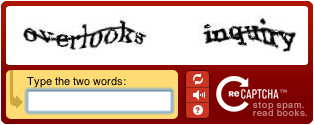CAPTCHA, or “Completely Automated Public Turing” is a type of reaction test generally used in the computing environment to establish whether the user is human or not. The term includes all technological tools used to distinguish humans from computers during online interaction.
The main purpose of CAPTCHA text is to prevent automatic computer processes from abusing e-mail systems by repeatedly entering passwords or from overloading or causing security problems on network services.
The most common example of CAPTCHA can be seen below and consists of a series of distorted or cross-hatched letters and numbers users have to retype. These distorted letters hidden in letters are easily recognised by humans, but computers find it difficult.
Unfortunately computers and CAPTCHA code hacking algorithms are becoming more sophisticated and subsequently the CAPTCHA codes also become more distorted and difficult for people to recognise.
The term was first used in 2000 by Luis von Ahn, Manuel Blum, Nicholas J. Hopper of the Carnegie Mellon University and John Langford of IBM. The most popular CAPTCHA was invented by Mark D. Lillibridge, Martin Abadi, Krishna Bharat and Andrei Z. Broder. This type of CAPTCHA prompts the user to retype letters displayed on a distorted image, sometimes also overshadowed by a series of other letters or numbers on the screen.
Seeing that this test, unlike the standard Turing test which is conducted by a person, is performed by a computer, it is often referred to as a reverse Turing test.
The CAPTCHA identification process for users has been heavily criticised, especially by disabled users, but also by other users who feel that their daily work is slowed down by distorted illegible words, even for people without disabilities.
Read more on CAPTCHA on the official website.
[SOURCE: http://www.webopedia.com/DidYouKnow/_index.asp and www.wikipedia.org]


